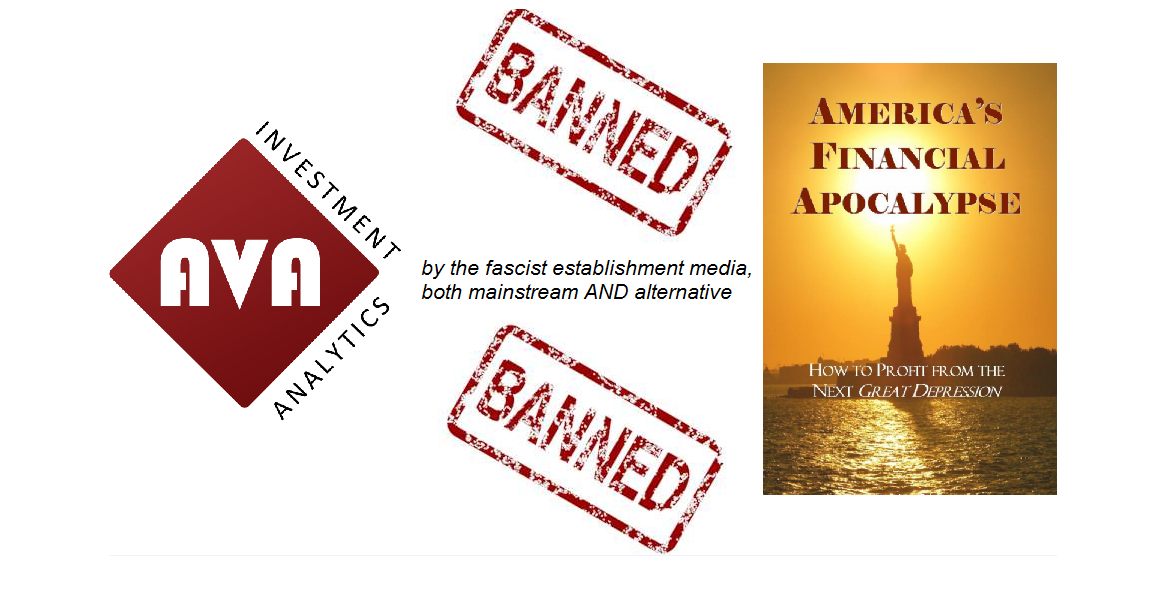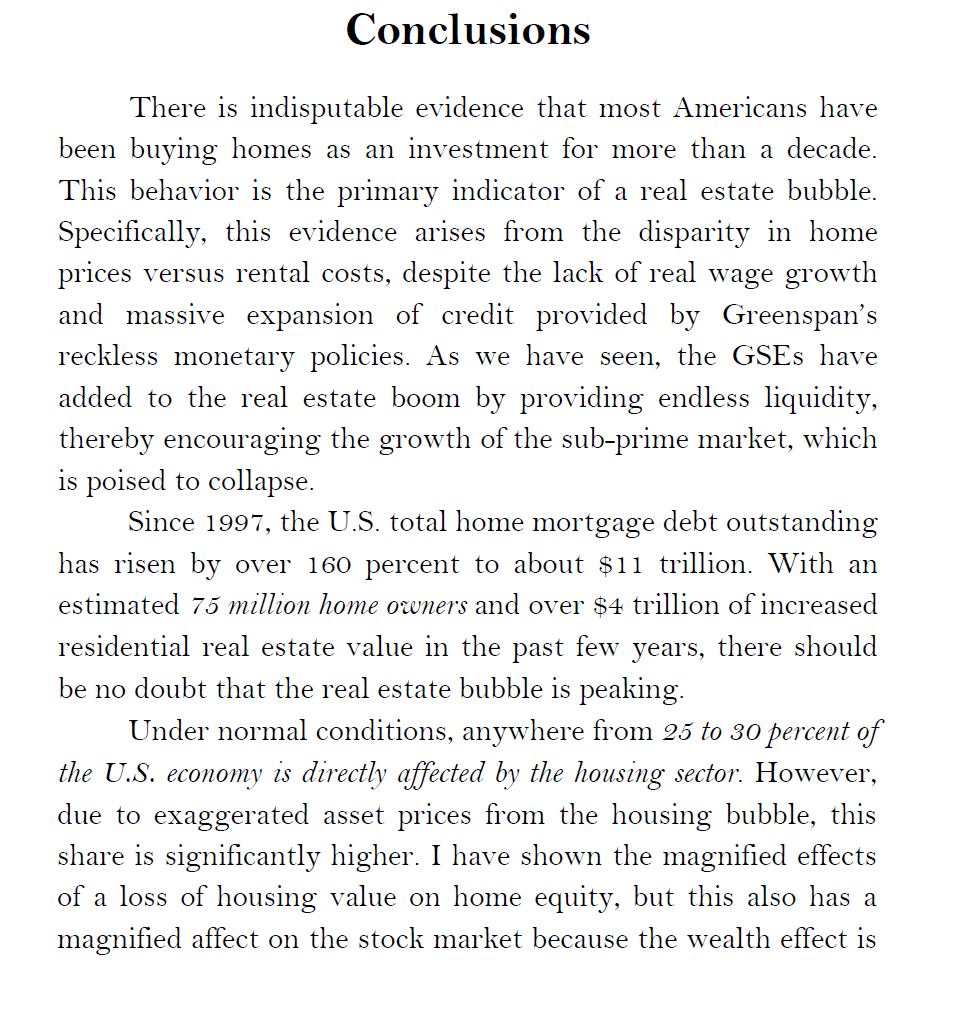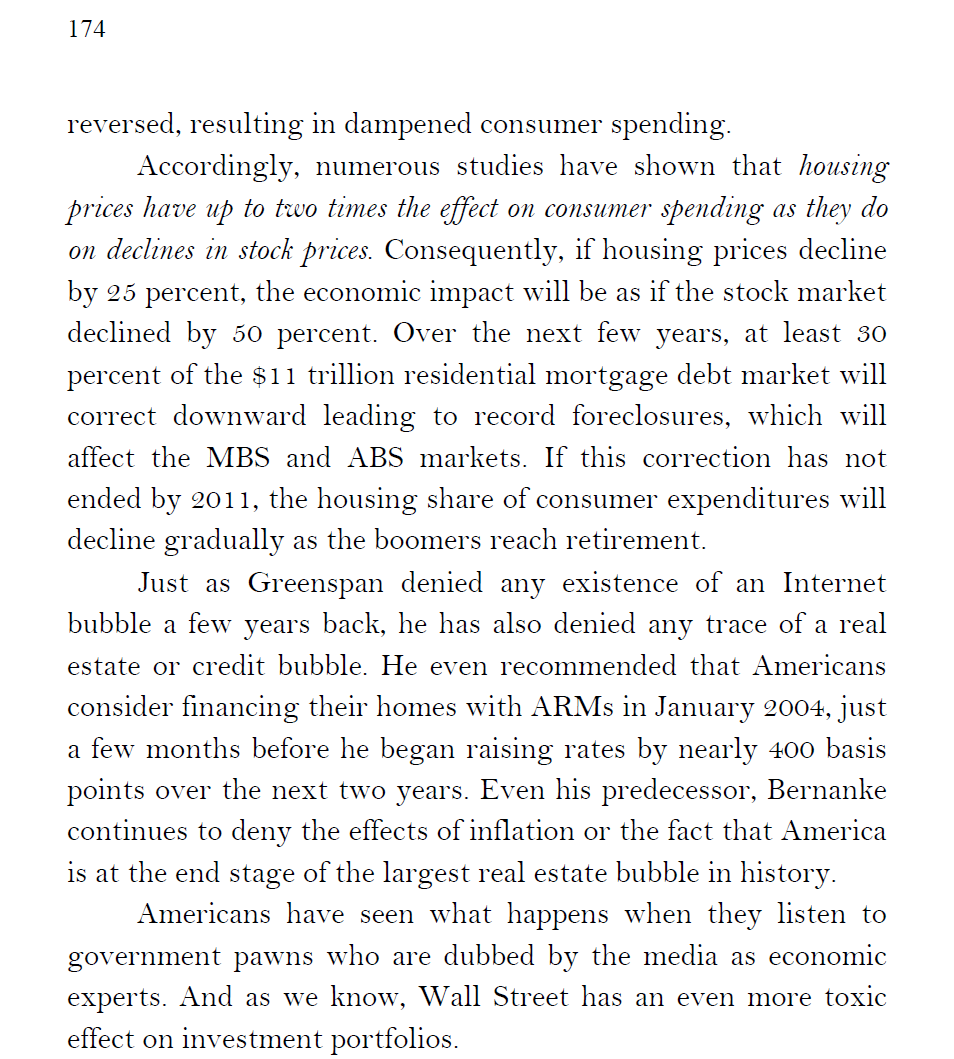 Investment Intelligence When it REALLY Matters.
Investment Intelligence When it REALLY Matters.
Blast from the Past - Mike Stathis Predicted the Real Estate Derivatives Meltdown in 2006

Here we offer more evidence that no one in the world came remotely .jpg) close to Mike Stathis in predicting the exact details of the financial crisis.
close to Mike Stathis in predicting the exact details of the financial crisis.
What is truly shocking as much as it is unfortunate for investors is that his book, America’s Financial Apocalypse remains virtually unknown.
Ask yourself why the media continues to ban the world’s leading investment expert while promoting con men who are always wrong.
Remember, if you lost money, the media is largely to blame because they promote jokers and con men.
At the end of the day, if you lost money it was your fault for paying attention to the media.
Warnings of a Derivatives Meltdown
Excerpts from Chapter 10 of America’s Financial Apocalypse:
How to Profit from the Next Great Depression (2006)
Furthermore, the GSEs have created very risky derivatives exposures for themselves and many financial institutions. As these debt instruments evolve into different products, less transparency and more uncertainty is created. Fannie Mae has taken about half of its MBS and pooled them into another security called a Real Estate Mortgage Investment Conduit (REMIC), otherwise known as a restructured MBS or Collateralized Mortgage Obligation (CMO). These mortgage derivatives are complex and considered very speculative.
According to recent data, the total derivative exposure for all securities stands at nearly $300 trillion. However, it’s not known for certain what the net exposure is. In other words, how much of these derivatives are used as hedging securities versus leverage. As a simple example, if $1 million in derivatives are in call options for Microsoft stock with the same strike price and expiration as another $1 million in put options, the net derivatives exposure is 0. Thus, even a 5 percent net exposure would be huge. It’s also not known with certainty how much of these derivatives are in mortgage-related securities, since only a small portion are listed in the collateralized securities markets.
I want you to stop and think for a minute about all of the fraudulent practices that have occurred within the housing industry, from known problems of poor workmanship and cheap materials by some builders, to inflated appraisals performed to generate ease of lending and to support cash-out deals. From inflated appraisals alone, 10 to 15 percent of MBS securities or up to $1.5 trillion have been overvalued by conservative estimates. Combine that with the lack of transparency, questionable risk exposure and fraudulent practices by executives at Fannie and Freddie, and you have a disaster ready to strike.
Now combine that with over 10 million Americans holding interest-only and ARM mortgages, throw in a million or two job losses due to say the failure of Delta, Ford, General Motors, or some other large vulnerable company, and you could end up with a blowup in the MBS market. This scenario would devastate the stock, bond and real estate markets. Most likely, there would also be an even bigger mess in the swaps and derivatives markets. In conclusion, the collateralized securities market is a very tall and fragile house of cards poised to collapse, and all it might take is one card to be dislodged. A breakdown in just one of the GSEs is very possible and could result in a financial collapse of far greater magnitude and scope than Enron, triggering massive losses.
America has become a nation of credit spending. And most believe that home ownership is the biggest and safest investment they will ever make. These perceptions have been further magnified since the deflation of the Internet bubble. However, as I have discussed, there are tremendous risks for both home owners and real estate investors alike. Already, outstanding residential mortgage debt has continued to surpass record levels. Even amidst tremendous price appreciation, the debt-to-value ratio is approaching record highs. When home prices correct downward, these effects will be more pronounced and the “poor effect” will kick in.
Housing prices are absolutely critical to the success of companies such as Lowe’s, Home Depot, and Sears. As well, most banks are closely tied to the health of the housing market because one way or another you can bet they have exposure to the MBS market. Many of the larger financial institutions have a much greater risk exposure with real estate derivative products. Overall, the biggest threat of this bubble may be the broad-reaching impact of a blow-up in the MBS market that would send shockwaves throughout the capital markets.
Based on today’s grossly overvalued housing prices, a 35 percent correction on average seems very likely. And in some areas, a 50 to 60 percent correction is possible. However, don’t expect a sudden collapse. Most likely, it will take several years for the real estate washout to be completed. We can only hope that the MBS market doesn’t experience its first blow up since inception, but don’t bet on it.
On average, since 2001, U.S. home prices have risen by over 57 percent, (33 percent adjusted for inflation) and in many cities this number is closer to 150 percent. As of June 2006, the median home price in America approached $230,000. Therefore, as it stands today, unless you take out a risky ARM or interest-only mortgage, the average home is not affordable for the average worker. Already, with short-term rates above 5 percent, ARMs are no longer an option, forcing those who cannot afford a home (but who believe real estate is a great investment) to take out interest-only loans.
Just as Greenspan denied any existence of an Internet bubble a few years back, he has also denied any trace of a real estate bubble. He even recommended that Americans consider financing their homes with ARMs in January 2004. A few months later, he began raising rates by nearly 400 basis points over the next two years.
There is indisputable evidence that most Americans have been buying homes as an investment vehicle for at least the past ten years. And this behavior is the primary indicator of a real estate bubble. Specifically, this evidence arises from the disparity in home prices versus rental costs, lack of real wage growth, and the massive expansion of credit provided by Greenspan’s reckless monetary policies. GSEs have added to the real estate boom by providing endless liquidity, thereby encouraging the growth of the sub-prime market.
Since 1997, the U.S. total home mortgage debt outstanding for has risen by over 160 percent to about $11 trillion. With an estimated 75 million home owners and over $4 trillion of increased residential real estate value in the past few years, there should be no doubt that the real estate bubble is peaking. At least 30 percent of the $11 trillion residential mortgage debt market will correct downward leading to record foreclosures, which will affect the MBS and ABS markets. If this correction has not ended by 2011, the housing share of consumer expenditures will decline gradually as the boomers reach retirement.
Under normal conditions, anywhere from 25 to 30 percent of the U.S. economy is directly affected by the housing sector. However, due to exaggerated asset prices from the housing bubble, this share is significantly higher. I have shown the magnified effects of a loss of housing value on home equity, but this also has a magnified effect on the stock market because the wealth effect is reversed, resulting in dampened consumer spending. Accordingly, numerous studies have shown that housing prices have up to two times the effect on consumer spending as they do on declines in stock prices. Consequently, if housing prices decline by 25 percent, the economic impact will be as if the stock market declined by 50 percent.

As a review, take a look at a portion of an article Mike published in 2009.
Ref: Blast From The Past: Real Estate Then And Now
From Chapter 10 of America’s Financial Apocalypse (2006)…
“Across the nation, even if we assume a very conservative 20 percent correction, there would still be several major regions that would experience declines of 35 to 40 percent. Declines of this magnitude would wipe out the wealth effect, as many watch their home equity evaporate into thin air. This will not only halt consumer spending, but it will also force millions of foreclosures across America, causing housing inventories to rise, which could cause a further collapse in home prices. The aftermath of record foreclosures will send shockwaves to the stock and bond markets.”
“This will cause a record number of foreclosures, as over 10 million are possible within the next 6 to 8 years.”
“Even the riskiest of these loans can be manipulated into AAA-rated debt and sold to pensions and other large funds because the same standards that apply to corporate debt are not applied to collateralized debt products.
“What would happen if one or more GSE (i.e. Fannie or Freddie) got into financial trouble? Not only would investors get crushed, but taxpayers would have to bail them out since the GSEs are backed by the government. Everyone would feel the effects. With close to $2 trillion in debt between Freddie Mac and Fannie Mae alone, as well as several trillion held by commercial banks, failure of just one GSE or related entity could create a huge disaster that would easily eclipse the Savings & Loan Crisis of the late 1980s.”
“The real estate fallout will no doubt cripple smaller companies such as mortgage lenders, home builders, and home improvement stores. But it will also affect huge financial institutions such as Citigroup, Bank of America, Chase, General Motors (GMAC), General Electric (GE Finance), and Washington Mutual, depending upon the extent of their exposure. As well, if things get really nasty the credit problems could extend to the ABS market which would cause further devastation.”
Ref: Blast From The Past: Real Estate Then And Now
In addition, you may want to review the concluding passage (below) from Cashing in on the Real Estate Bubble (released early 2007).
Two chapters from this book have been released for free.


.png)
Click here to download two chapters from Cashing in on the Real Estate Bubble.
Check here, here and here for more evidence proving that Mike Stathis predicted the extent of the real estate bubble and resulting financial crisis with more insight and accuracy than anyone in the world.Note that this was just the "tip of the iceberg" as far as his predictions and insights.
Forget the sub-primes. The trouble with these risky mortgage stocks was obvious to leading experts. While Mike Stathis recommended to short an entire basket of the sub-prime stocks, he took things to a much higher level with one of the boldest calls in investment history. The truly amazing call he made was to also short the prime lenders, Fannie Mae and Freddie Mac.
Furthermore, he even predicted the collapse of the banks, hombuilders, GE and GM. No one else in the world made those calls before the financial crisis. And Mike put it in a book in 2007.
.png)
.png)
It is a fact that there were no books released at any time prior to for after the release of these books which remotely came close to pinpointing the details and accuracy of the events as they would later unfold. And this serves as just one of numerous illustrations.
Mike also accurately forecast the bottom in real estate (35%) in 2006 (the bottom was reached in 2011), the bottom in the Dow Jones (6500) in 2006 (the bottom was reached in March 2009) and much much more.
Proof That Mike Stathis Has The Leading Track Record On The Economic Collapse
Copyrights © 2025 All Rights Reserved AVA investment analytics